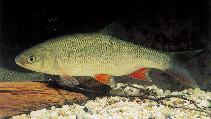Upload your photos and videos
Pictures | Videos | Google imageLeuciscus idus
Picture by Zienert, S.
Pictures | Videos | Google imageLeuciscus idus
Picture by Zienert, S.
Common names from other countries
Classification / Names ຊື່ສາມັນ | ຄຳສັບຄ້າຍຄືກັນ | Catalog of Fishes(ຕະກຸນ, ຊະນິດ) | ITIS | CoL | WoRMS | Cloffa
> Cypriniformes (Carps) > Leuciscidae (Minnows) > Leuciscinae
Etymology: Leuciscus: Greek, leykiskos = white mullet (Ref. 45335).
More on author: Linnaeus.
Etymology: Leuciscus: Greek, leykiskos = white mullet (Ref. 45335).
More on author: Linnaeus.
Environment: milieu / climate zone / depth range / distribution range ນິເວດວິທະຍາ
; ນ້ຳຈືດ; ນ້ຳກ່ອຍ ກ່ຽວກັບ (ຢູ່)ເທິງຊັ້ນພື້ນດິນໃນທະເລເປີດ; pH range: 7.0 - 7.5; dH range: 10 - 15; ກຸ່ມຫຼືຊະນິດປາທີ່ມີການເຄື່ອນຍ້າຍພາຍໃນນ້ຳຈືດ (Ref. 51243); ລະດັບຄວາມເລິກ 15 - ? m (Ref. 5732). Temperate; 4°C - 20°C (Ref. 1672); 73°N - 37°N, 7°E - 136°E
ການແຜ່ກະຈາຍ ປະເທດ | ເຂດ FAO | ລະບົບນິເວດ | ການປະກົດຕົວ | Point map | ການແນະນຳ | Faunafri
Europe and Asia: Baltic, Black, northern Caspian and North Sea basins, Atlantic basin southward to Seine and lower Loire drainages (France). Absent in Scandinavia north of 69°N. In Asia, eastward to Lena drainage and Aral basin. Introduced to Great Britain and northern Italy (Ref. 59043). Transported to several countries in Europe and the United States for ornament (Ref. 4537).
Length at first maturity / ຂະໜາດ / ນ້ຳໜັກ / Age
Maturity: Lm ? range ? - ? cm
Max length : 85.0 cm SL ຕົວຜູ້/ບໍ່ມີເພດ; (Ref. 59043); common length : 30.0 cm TL ຕົວຜູ້/ບໍ່ມີເພດ; (Ref. 556); ນ້ຳໜັກສູງສຸດທີ່ເຄຍຈັດພີມມາ: 4.0 kg (Ref. 556); ອາຍຸສູງສຸດທີ່ເຄຍລາຍງານມາ: 29 ປີ (Ref. 126842)
Max length : 85.0 cm SL ຕົວຜູ້/ບໍ່ມີເພດ; (Ref. 59043); common length : 30.0 cm TL ຕົວຜູ້/ບໍ່ມີເພດ; (Ref. 556); ນ້ຳໜັກສູງສຸດທີ່ເຄຍຈັດພີມມາ: 4.0 kg (Ref. 556); ອາຍຸສູງສຸດທີ່ເຄຍລາຍງານມາ: 29 ປີ (Ref. 126842)
Short description ຕົວທີ່ໃຊ້ໃນການຈຳແນກຊະນິດ | ສະລີລະວິທະຍາ | ການວັດແທກຮູບຮ່າງລັກສະນະພາຍນອກຂອງດິນ,ສັດ,ປາ…
ຄີ (ໜາມ)ແຂງຢູ່ຫຼັງປາ (ທັງໝົດ) : 3; ຄີຫຼັງຂອງປາ (ຄີອ່ອນ) (ທັງໝົດ) : 8 - 11; ຄີ(ໜາມ) ແຂງຢູ່ຄີກົ້ນປາ
ກຸ່ມປາກະດູກແຂງ
ຄວາມຖີ່ຂອງກຸ່ມຖ່າຍທອດພັນ
ປາທີ່ມີການເຄື່ອນຍ້າຍຈາກທະເລໄປຫານ້ຳຈືດ ແລະນ້ຳຈືດຫາທະເລ
ປາທີ່ມີການເຄື່ອນຍ້າຍຈາກທະເລແລະໄປໄຂ່ຢູ່ນ້ຳຈືດ
ຄີກົ້ນຂອງປາ
ສັດທີ່ມີກະດູກສັນຫັຼງ
ການຖ່າຍທອດທາງກຳມະພັນຈາກພໍ່ແມ່ຫາລູກ: 3; ຄີກົ້ນຂອງປາ: 8 - 11; ສັດທີ່ມີກະດູກສັນຫຼັງ: 47. Diagnosed from congeners in Europe by the following characters: lateral line with 56-58 + 3 scales; pharyngeal teeth 3,5-5,3; mouth terminal; dorsal fin with 8½ branched rays; anal fin with 10-11½ branched rays; all fins except dorsal fin with reddish tinge; pigmentation on lateral scales lacking regular black mesh (Ref. 59043). Caudal fin with 19 rays (Ref. 2196).
Usually inhabits large lowland rivers and nutrient-rich lakes. Adults are solitary while juveniles are gregarious. Undertakes migration to tributaries to spawn in moderate current on gravel or submerged vegetation. Feeds on various aquatic and terrestrial animals and plant material. Larger individuals feed mainly on fishes. Feeding larvae and juveniles thrive in a wide variety of shoreline habitats and leave the shores for deeper waters when growing. Reported to sometimes hybridizes with Aspius aspius (Ref. 59043). Its flesh is not tasty (Ref. 30578). Aquarium keeping: at least 10 individuals; minimum aquarium size >200 cm; not recommended for home aquariums (Ref. 51539).
Life cycle and mating behavior ການຈະເລີນເຕັມໄວ | ການສືບພັນ | ການວາງໄຂ່ | ໄຂ່ | ຄວາມດົກຂອງໄຂ່ປາ | ຕົວອ່ອນ
"Females spawn only once each season. Individual females spawn with several males. Males assemble at spawning grounds and follow ripe females. Females attach the sticky eggs to gravel or submerged plant material" (Ref. 59043).
Main reference
Upload your references | ເອກະສານອ້າງອີງ | ຜູ້ປະສານງານ | ຜູ້ຮ່ວມມື
Kottelat, M. and J. Freyhof, 2007. Handbook of European freshwater fishes. Publications Kottelat, Cornol and Freyhof, Berlin. 646 pp. (Ref. 59043)
IUCN Red List Status (Ref. 130435: Version 2024-2)
Least Concern (LC) ; Date assessed: 22 October 2023
Threat to humans
Harmless
Human uses
ການປະມົງ: ເປັນສີນຄ້າ; ຊະນິດປາທີ່ຖືກນຳໃຊ້ເຂົ້າໃນການຫາເພື່ອເປັນເກມກິລາ: ແມ່ນ; ຕູ້ປາ: ເປັນສີນຄ້າ
FAO(Aquaculture systems: ຜົນຜະລິດ; ການປະມົງ: ຜົນຜະລິດ; publication : search) | FishSource | ທະເລອ້ອມຂ້າງພວກເຮົາ
ຂໍ້ມູນຕື່ມອີກ
Population dynamics
ຕົວວັດແທກການເຕີບໃຫຍ່
Max. ages / sizes
Length-weight rel.
Length-length rel.
Length-frequencies
Mass conversion
ການທົດແທນທີ່
ຄວາມອຸດົມສົມບູນ
ຕົວວັດແທກການເຕີບໃຫຍ່
Max. ages / sizes
Length-weight rel.
Length-length rel.
Length-frequencies
Mass conversion
ການທົດແທນທີ່
ຄວາມອຸດົມສົມບູນ
Life cycle
ການສືບພັນ
ການຈະເລີນເຕັມໄວ
ຄວາມດົກຂອງໄຂ່ປາ
ການວາງໄຂ່
Spawning aggregations
ໄຂ່
Egg development
ຕົວອ່ອນ
ການປ່ຽນແປງຂອງຕົວອ່ອນ
ການສືບພັນ
ການຈະເລີນເຕັມໄວ
ຄວາມດົກຂອງໄຂ່ປາ
ການວາງໄຂ່
Spawning aggregations
ໄຂ່
Egg development
ຕົວອ່ອນ
ການປ່ຽນແປງຂອງຕົວອ່ອນ
Anatomy
ເນື້ອທີ່ເຫືອກ
Brain
Otolith
ເນື້ອທີ່ເຫືອກ
Brain
Otolith
Physiology
Body composition
Nutrients
ການບໍລິໂພກອົກຊີເຈນ
ປະເພດການລອຍ
ຄວາມໄວໃນການລອຍ
Visual pigments
Fish sound
Diseases & Parasites
Toxicity (LC50s)
Body composition
Nutrients
ການບໍລິໂພກອົກຊີເຈນ
ປະເພດການລອຍ
ຄວາມໄວໃນການລອຍ
Visual pigments
Fish sound
Diseases & Parasites
Toxicity (LC50s)
Human related
Aquaculture systems
ຂໍ້ມູນການລ້ຽງສັດນ້ຳ
ສາຍພັນ
Ciguatera cases
Stamps, coins, misc.
Aquaculture systems
ຂໍ້ມູນການລ້ຽງສັດນ້ຳ
ສາຍພັນ
Ciguatera cases
Stamps, coins, misc.
ເຄື່ອງມື
Bio-Quiz | E-book | ຄູ່ມືພາກສະໜາມ | ຕົວທີ່ໃຊ້ໃນການຈຳແນກຊະນິດ | ຄວາມຖີ່ຂອງຄວາມຍາວປາ | ເຄື່ອງມືຂອງຊີວະປະຫວັດທາງດ້ານຊີວິດ | ຈຸດໃດໜຶ່ງທີ່ສະແດງອອກໃນແຜນທີ່ (ພ້ອມທັງສະແດງຂໍ້ມູນເພີ້ນເຕີມ) | Classification Tree
| Catch-MSY |
Special reports
Download XML
ແຫຼ່ງອີນເຕີເນັດ
Alien/Invasive Species database | Aquatic Commons | BHL | Cloffa | Websites from users | Check FishWatcher | CISTI | Catalog of Fishes(ຕະກຸນ, ຊະນິດ) | DiscoverLife | DORIS | ECOTOX | Faunafri | Fishtrace | GenBank(genome, nucleotide) | GloBI | GOBASE | | Google Books | Google Scholar | Google | IGFA World Record | MitoFish | ຖານຂໍ້ມູນແຫ່ງຊາດ | Otolith Atlas of Taiwan Fishes | ບ່ອນວາງສະແດງສັນນ້ຳຂອງລັດ | PubMed | Reef Life Survey | Scirus | SeaLifeBase | ແຜນທີ່ສະແດງກິ່ງງ່າຂອງເຊື້ອຕະກຸນປາ, ສັດ ຈາກບັນພະບູລຸດຈົນເຖິງຫລານ | Wikipedia(Go, ຊອກຫາ) | World Records Freshwater Fishing | ການບັນທຶກດ້ານສັດວິທະຍາ
Estimates based on models
Phylogenetic diversity index (Ref. 82804): PD50 = 0.5000 [Uniqueness, from 0.5 = low to 2.0 = high].
Bayesian length-weight: a=0.00589 (0.00484 - 0.00717), b=3.15 (3.12 - 3.18), in cm Total Length, based on LWR estimates for this species (Ref. 93245).
ຊັ້ນເຂດຮ້ອນ (Ref. 69278): 3.8 ±0.59 se; based on food items.
ຄວາມຢືດຢຸ່ນ (Ref. 120179): ຕຳ່, ປະຊາກອນຕຳ່ສຸດທີ່ໃຊ້ເວລາສອງເທົ່າ 4.5 - 14 ປີ (tm=5-9).
Fishing Vulnerability (Ref. 59153): High to very high vulnerability (69 of 100).




